Reverse Logistic Strategy for the Management of Tire Waste in Mexico and Russia: Review and Conceptual Model
Abstract
:1. Introduction
- Reverse Logistics (RL) encompasses all the logistic activities from used products which are no longer required by the users to products again usable in a market. Within the environmental context, RL has been successfully applied for recovery, recycling and reuse of end-of-life electrical and electronic equipment [3,4,5]. Figure 1 presents the basic activities or processes in an RL system [6].
- as transport is one of the main logistic activities, there is an increasing demand for new tires and generation of scrap tires (end-of-life tires). Globally, an estimated one billion tires reach the end of their useful lives every year;
- scrap tires are usually shredded and disposed of in landfills, or stockpiled whole. Stockpiling leads to two significant hazards: it creates an ideal breeding ground for disease-carrier fauna, and fires;
- the void space of tires in landfills capture explosive methane gas which can represent a fire hazard, contaminate local water systems, and damage the landfill liners;
- chemical components such as stabilizers and flame retardants added to tires can kill advantageous bacteria in the soil.
- policies and regulations;
- supporting institutions;
- proper financial mechanisms;
- stake holder participation; and
- supporting technologies.
- review of the factors (i.e., policies and regulations, supporting institutions, financial mechanisms) regarding the current tire waste management strategies in the EU, Japan, Mexico and Russia;
- analysis regarding the most important RL processes in these strategies associated with economic and sustainable benefits;
- development of a conceptual integrated RL model with these processes. The proposed RL model is focused on re-manufacturing or retreading and diversification to make it economically accessible and sustainable.
2. Organizational and Managerial Aspects of Reverse Logistics in Companies
- The existence or absence of a traditional logistic system which can allow the reverse function.
- The type of product of interest in terms of its technology, ease of recovery, level of standardization, technical characteristics, etc.
- The recovery option (recycling, re-manufacturing or reuse) that will be applied to the returned product.
- The purpose of the RL system.
- The size of the company and its business objectives.
- The structure of the distribution channel.
- Company. In this case, the company itself designs, manages and controls the recovery and reuse of its out-of-use products. Companies that develop their own RL systems are often characterized by being leaders in their respective markets in which the identification between company and product is very high. They are generally manufacturers of complex and technologically advanced products, designed to recover some of the added value that they incorporated (e.g., Design for the Environment—DFE, Design for Dismantling—DFDA). Although the ultimate responsibility for the system is the company itself, it is usual for some activities to be carried out by third-parties outside the company (e.g., the collection of products and their transport to the recovery center). The productive process considered to recover the added value of the out-of-use product is usually a complex process, with multiple tasks, in which there is an intensive use of labor. The logistic network that is developed to recover these products is characterized by being a complex, multi-link network, generally decentralized in which the recovered product is reintroduced into the original closed-loop Supply Chain (SC).
- Third-Party. In this case, the company responsible for the introduction of the product in the market does not directly manage the recovery process and this function is performed, for the most part, by third-parties outside the company. In this way the company can either choose to participate in an Integrated Management System or hire the services of Logistics Professionals specialized in the realization of RL services (e.g., organizations that promote and manage the recovery of out-of-use products for its subsequent treatment or proper disposal, generally these are constituted by suppliers, manufacturers, and distributors, who are the financiers of the scheme).
- RL is not recognized as a factor that can generate a competitive advantage;
- belief that once the products are delivered, the responsibility of the company ends (to solve it, it is necessary to take into account a life cycle approach linked to the final distribution);
- failure to bridge the internal, external and associated processes in the E-Commerce and the return aspect of products in the SC (associated with process mapping, to understand its scope and complexity);
- assumption that part-time efforts are sufficient to deal with RL activities (RL is not recognized as a complex action that must have its own resources);
- belief that order-time cycles for returned products may be larger and more variable than those associated with the sale or distribution of new products;
- assumption that returned products and recycling and re-use of packaging will take care of themselves if enough time is given;
- difficult separation of products because commonly these arrive mixed at the distribution centers;
- belief that returned products are relatively unimportant in terms of costs, asset valuation, and potential revenues (returns tend to stay longer than new products on direct channels, resulting in high inventory, transportation, and storage costs, and at the same time, revenues decrease due to costs associated with obsolescence and degradation).
3. Reverse Logistics and Regulations in Russia, Mexico, the EU and Japan
3.1. Russian Context
- underestimation of the importance of logistic processes in business activities;
- lack of a unified approach to understand RL in Russian literature (which causes misunderstandings and discussions, as well as making the study and implementation of the best practices of RL in organizations more difficult);
- insufficient explanation in the scientific literature of practical recommendations for the implementation of RL in the activities of Russian companies and evaluation of their effectiveness.
Regulations for Tire Waste
3.2. Mexican Context
Regulations for Tire Waste
- there are no policies to make the collection and transportation of tires economically feasible;
- there are no policies to motivate or regulate the participation of companies specialized into recovery (collection, cleaning and re-conditioning) of this type of waste;
- the management of tire collection has been driven by market conditions; unfortunately, this collection chain is disaggregated from the parties such as the automotive industry and the manufacturing industry of tires. The main reason for this is the lack of already consolidated networks that add value to the end of the tires’ useful life [50].
3.3. Context of Japan and the European Union
3.4. Entities Involved within RL Processes for Used Tires
- Networks for Recycling of Tires. They are usually simple structures, with few centralized links that are characterized by requiring, for an efficient management, a high volume of inputs (tires of waste) generally of little unit value. The high transformation costs determine the need for high utilization rates of these networks and the search for economies of scale.
- Networks for the Re-manufacturing of Tires. Its main objective is the recovery of parts and components of tires with high added value. In these systems, the original manufacturers usually play a very important role, sometimes being solely responsible for the design and management of RL systems. The design of the network responds to a multi-level, decentralized typology, for which synergies are usually sought with the direct channel.
- Reusable Tire Networks. In these systems, the recovered tires are reintroduced in the SC once the necessary cleaning and maintenance operations have been carried out. They tend to be decentralized structures where both original and reused tires circulate simultaneously and in which the cost of transport appears as the most significant.
4. Proposed RL Strategy for Tire Waste
- If efficient processes of re-use or re-manufacturing of goods (whether fast and inexpensive) are established, the cost of raw material and production of new goods can be reduced (instead of re-making a tire, re-conditioning of a used tire can be cheaper).
- The collection of used tires that are candidates for re-conditioning must be efficient (e.g., it must be of minimum time). Therefore, the optimization of collection routes can provide faster and cheaper re-utilization processes that can substitute a percentage of the purchase cost of raw material or manufacturing (from scratch) of a new product.
- Improvement in the environmental aspect is a consequence of these measures, and better government support (investment funds) can be accessed if these practices are encouraged.
- If a fixed area of re-conditioning of tires is established, it will be possible to have an area that receives raw material (in this case, used tires) that can give sustenance to inventory in case of breakdown. This also involves savings and service level improvement.
- On the other hand, tires that have reached the end of their useful life (it is not possible to re-condition them) support other industries (generate income).
4.1. Re-Manufacturing or Retreading Strategy
- Maintenance and replacement of tires is the third highest cost for fleet operators, after labor and fuel.
- The renewal rate for tire replacement is much higher for heavy truck fleets.
- Tire retreading is desirable from the point of view of economic and material saving.
- Reduction of energy savings in the field of transient technological changes in tires;
- Reconditioning of energy-saving tires in the field of inefficiency of degradation of retreaded tires compared to new equivalent tires;
- Energy saving of retreading of tires in the scope of the variations of the product.
4.2. Diversification Strategy
4.3. Integrated RL Scheme
- a third-party (public or private) company can perform the whole process of collection, classification, and re-manufacturing of the out-of-use tire;
- the manufacturing company itself can extend its participation within the RL process assuming some responsibilities.
- The first logistic chain considers that the product is recovered by the same company that manufactures it (thus, the company only recovers the tires that were manufactured by it).
- The second logistic chain considers that the company recovers (1) its own tires, and (2) tires manufactured by its competition (e.g., other companies), leading to reach a greater volume of tires to carry out its processing.
- The third logistic chain considers that the entire recovery process is carried out by a third-party company, which may be contracted by the manufacturer whose product is collected for the same purpose. This chain can also be extended for the creation of other products (diversification), either by means of this contracted company or by the manufacturing company itself. The third-party company can also perform the whole process or simply be a part of it.
- The fourth logistic chain is related to the previous chain and it represents the case in which the company that is collecting the product does it for a different manufacturing process than the production of tires. This leads to the diversification for new markets.
- Manufacturing processes focused on decreasing rolling resistance of tires. This can lead to improving fuel efficiency, reducing emissions, and extending the useful life of the tire [54].
- Standard use of the “Reduce Index” (Re Index) to objectively measure and assess processes focused on achieving a longer wear life of tire for different vehicles [54].
- Use of recycled tire crumb (RTC) for the manufacturing of construction materials. The RTC has been identified as a promising approach to create lightweight cellular concrete (LCC) due to its insulation properties regarding sound, water, and temperature [25]. Countries with regions with extreme weather conditions such as Russia can get benefits from this proposal.
- Recycling processes based on state-of-the-art advances in chemical studies on the effects of amount, size and morphology of rubber granulate grains for the creation of modern polymer-rubber composites from used tires [26].
- Extend on thermo-mechanical devulcanization based on extrusion as a standard for recycling on an industrial scale. As discussed in [23], it is the most environmentally appropriate approach to tire recycling in comparison to chemical, ultrasound, microwave, and mechanical devulcanization.
5. Discussion on Findings
- while incentives are considered within the EPR, and the company can rely on third-party companies for collection, recycling and re-manufacturing (including diversification), some processes may be too expensive and/or complex. This can limit the intended impact or commitment of all entities within the SC;
- implementation and compliance of new RL legislation may represent additional administrative and economic burden to local governments;
- among the critical factors for recycling are the management and transportation costs which must be performed by the responsible entity. In general, the collection of tire waste is not only carried out by the public (i.e., government) companies, but also by private companies that use this waste as raw material for their production processes (e.g., diversification). While transportation costs have reduced the collection tasks due to inefficient route planning, there is also an inefficient cooperation between public and private companies to accomplish these tasks.
- savings in the energy used for production by 66.0%;
- 30.0–50.0% cheaper than the manufacturing cost of a new tire;
- a re-manufactured tire can have a useful life of 75.0–100.0% when compared to a new tire;
- very appropriate for heavy truck operators where the tire replacement rate is high.
6. Conclusions
- design of a Green-Reverse logistic model (e.g., by means of mixed integer linear programming) to improve the distribution network required for the collection, recycling, and diversification tasks;
- incorporation of economic variables within the RL structure to establish an efficient business model between all entities involved in the recycling process;
- incorporation of inventory supply strategies as a mean to optimize tire waste processing.
Author Contributions
Funding
Acknowledgments
Conflicts of Interest
References
- Rutner, S.M.; Langley, C.J. Logistics Value: Definition, Process and Measurement. Int. J. Logist. Manag. 2000, 11, 73–82. [Google Scholar] [CrossRef]
- Council of Logistics Management. Council of Logistics Management 1998 Annual Conference—Logistics Excellence: Vision, Processes, and People; Council of Logistics Management: Anaheim, CA, USA, 1998. [Google Scholar]
- Zhao, C.; Liu, W.; Wang, B. Reverse Logistics. In Proceedings of the 2008 International Conference on Information Management, Innovation Management and Industrial Engineering, Taipei, Taiwan, 19–21 December 2008; pp. 349–353. [Google Scholar]
- Barker, T.J.; Zabinsky, Z.B. A multicriteria decision making model for reverse logistics using analytical hierarchy process. Omega 2011, 39, 558–573. [Google Scholar] [CrossRef]
- Gomez-Montoya, R.A.; Correa-Espinal, A.A.; Vasquez-Herrera, L.S. Reverse Logistics. An Approach with Business Social Responsibility (In Spanish). Criterio Libre 2012, 10, 143–158. [Google Scholar]
- Rubio, L.S. El Sistema de Logística Inversa en la Empresa: Análisis y Aplicaciones. Ph.D. Thesis, Universidad de Extremadura, Badajoz, Spain, 2003. (In Spanish). [Google Scholar]
- Guirong, Z.; Qing, G.; Bo, W.; Dehua, L. Green logistics and Sustainable development. In Proceedings of the 2012 International Conference on Information Management, Innovation Management and Industrial Engineering, Sanya, China, 20–21 October 2012; pp. 131–133. [Google Scholar]
- Seroka-Stolka, O. The development of green logistics for implementation of sustainable development strategy in companies. Procedia Soc. Behav. Sci. 2014, 151, 302–309. [Google Scholar] [CrossRef]
- Rodrigue, J.P.; Slack, B.; Comtois, C. Green logistics. In Handbook of Logistics and Supply Chain Management; Brewer, A.M., Button, K.J., Hensher, D.A., Eds.; Emerald Group Publishing Limited: Bingley, UK, 2008; pp. 339–350. [Google Scholar]
- Sbihi, A.; Eglese, R.W. Combinatorial optimization and Green Logistics. Ann. Oper. Res. 2009, 175, 159–175. [Google Scholar] [CrossRef] [Green Version]
- Scott, C.; Lundgren, H.; Thompson, P. Guide to Supply Chain Management; Springer: Berlin, Germany, 2011. [Google Scholar]
- Nylund, S. Reverse Logistics and Green Logistics. Master’s Thesis, Vaasan Ammattikorkeakoulu Vasa Yrkeshogskola University of Applied Sciences, Vaasa, Finland, 2012. [Google Scholar]
- Kumar, A. Green Logistics for Sustainable Development: An Analytical Review. IOSRD Int. J. Bus. 2015, 1, 7–13. [Google Scholar]
- Secretaría del Medio Ambiente (SEDEMA). Inventario de Residuos Sólidos; SEDEMA: Ciudad de México, Mexico, 2015. (In Spanish)
- Adhikari, B.; De, D.; Maiti, S. Reclamation and recycling of waste rubber. Prog. Polym. Sci. 2000, 25, 909–948. [Google Scholar] [CrossRef]
- World Business Council for Sustainable Development (WBCSD). Managing End-of-Life Tires; World Business Council for Sustainable Development: Geneva, Switzerland, 2008. [Google Scholar]
- Tomenco, L.; Zagodyakin, G. Analysis of the return supply chain for the processing of used automobile tires with the use of agent modeling. Successes Chem. Chem. Technol. 2013, 27, 51–55. (In Russian) [Google Scholar]
- UN-UNEP. Revised Technical Guidelines for the Environmentally Sound Management of Used and Waste Pneumatic Tyres; United Nations (UN): Basel, Switzerland, 2011. [Google Scholar]
- Sebola, M.R.; Mativenga, P.T.; Pretorius, J. A Benchmark Study of Waste Tyre Recycling in South Africa to European Union Practice. Procedia CIRP 2018, 69, 950–955. [Google Scholar] [CrossRef]
- Molino, A.; Donatelli, A.; Marino, T.; Aloise, A.; Rimauro, J.; Iovane, P. Waste tire recycling process for production of steam activated carbon in a pilot plant. Resour. Conserv. Recycl. 2018, 129, 102–111. [Google Scholar] [CrossRef]
- Park, J.; Diaz-Posada, N.; Mejia-Dugand, S. Challenges in implementing the extended producer responsibility in an emerging economy: The end-of-life tire management in Colombia. J. Clean. Prod. 2018, 189, 754–762. [Google Scholar] [CrossRef]
- Aoudia, K.; Azem, S.; Hocine, N.; Gratton, M.; Pettarin, V.; Seghar, S. Recycling of waste tire rubber: Microwave devulcanization and incorporation in a thermoset resin. Waste Manag. 2017, 60, 471–481. [Google Scholar] [CrossRef] [PubMed]
- Asaro, L.; Gratton, M.; Seghar, S.; Hocine, N. Recycling of rubber wastes by devulcanization. Resour. Conserv. Recycl. 2018, 133, 250–262. [Google Scholar] [CrossRef]
- Pavlovich, L.; Solovyova, N.; Strakhov, V. Utilizing waste tires with steel cord in coke production. Coke Chem. 2017, 60, 119–126. [Google Scholar] [CrossRef]
- Kashani, A.; Ngo, T.D.; Mendis, P.; Black, J.R.; Hajimohammadi, A. A sustainable application of recycled tyre crumbs as insulator in lightweight cellular concrete. J. Clean. Prod. 2017, 149, 925–935. [Google Scholar] [CrossRef]
- Sienkiewicz, M.; Janik, H.; Borzedowska-Labuda, K.; Kucinska-Lipka, J. Environmentally friendly polymer-rubber composites obtained from waste tyres: A review. J. Clean. Prod. 2017, 147, 560–571. [Google Scholar] [CrossRef]
- Derakhshan, Z.; Ghaneian, M.; Mahvi, A.; Conti, G.; Faramarzian, M.; Dehghani, M.; Ferrante, M. A new recycling technique for the waste tires reuse. Environ. Res. 2017, 158, 462–469. [Google Scholar] [CrossRef] [PubMed]
- Blanco-Machin, E.; Travieso-Pedroso, D.; Andrade-de-Carvalho, J. Energetic valorization of waste tires. Renew. Sustain. Energy Rev. 2017, 68, 306–315. [Google Scholar] [CrossRef]
- Tsai, W.-T.; Chen, C.-C.; Lin, Y.-Q.; Hsiao, C.-F.; Tsai, C.-H.; Hsieh, M.-H. Status of waste tires’ recycling for material and energy resources in Taiwan. J. Mater. Cycles Waste Manag. 2017, 19, 1288–1294. [Google Scholar] [CrossRef]
- Torretta, V.; Rada, E.; Ragazzi, M.; Trulli, E.; Istrate, I.; Cioca, L. Treatment and disposal of tyres: Two EU approaches. A review. Waste Manag. 2015, 45, 152–160. [Google Scholar] [CrossRef] [PubMed]
- Price, W.; Smith, E. Waste tire recycling: Environmentally benefits and commercial challenges. Int. J. Environ. Technol. Manag. 2006, 6, 362–374. [Google Scholar] [CrossRef]
- Connor, K.; Cortesa, S.; Issagaliyeva, S.; Meunier, A.; Bijaisoradat, O.; Kongkatigumjorn, N.; Wattanavit, K. Developing a Sustainable Waste Tire Management Strategy for Thailand. Bachelor’s Thesis, Worcester Polytechnic Institute (WPI), Worcester, MA, USA, 2013. [Google Scholar]
- Stock, J.R. The 7 Deadly Sins of Reverse Logistics. Mater. Handling Logist. 2001, 56, MHS5. [Google Scholar]
- Padilha, F.; Hilmola, O. Green Transport Practices and Shifting Cargo from Road to Rail in Finnish-Russian Context. Available online: https://dialnet.unirioja.es/servlet/articulo?codigo=3438108 (accessed on 6 September 2018).
- Zueva, O.; Shakhnazaryan, S. Logistics of Return Flows of Secondary Resources. Bull. Balt. Fed. Univ. Hum. Soc. Sci. 2014, 9, 140–147. (In Russian) [Google Scholar]
- Zueva, O.; Shakhnazaryan, S. Peculiarities of Introducing Reverse Logistics in Supply Chains. J. Ural State Univ. Econ. 2016, 4, 108–116. [Google Scholar]
- Ovezov, B.; Fen, C. Reverse Logistics. Young Sci. Econ. Manag. 2016, 1, 441–446. (In Russian) [Google Scholar]
- Gromov, V. Green Logistics in Russia. Russ. J. Logist. Transp. Manag. 2014, 1, 36–44. [Google Scholar] [CrossRef]
- Shahnazaryan, S.; Potapova, S. The problem of defining the concept of “returnable logistics” and its role in supply chain management. J. Ural State Univ. Econ. 2013, 46, 123–128. (In Russian) [Google Scholar]
- Weibold: Tyre Recycling Consulting. Tire Recycling Development in Crimea. Available online: https://weibold.com/tire-recycling-development-in-crimea/ (accessed on 21 November 2016).
- Akishin, A. Organizational and Economic Mechanism and Risk Management Tools in the Supply Chain of Enterprises in the Tire Industry; Russian Chemical and Technical University: Moscow, Russia, 2011. (In Russian) [Google Scholar]
- Recycling Points. Recycling of Automobile Tires. Available online: http://punkti-priema.ru/drugoe-vtorsiryo/utilizaciya-pokrishek (accessed on 3 May 2014).
- Technological Resources. Features of Grinding Domestic Tires and Differences between Imported and Domestic Tires. Available online: http://www.stanki-ru.ru/poleznaya-informatsiya/osobennosti-pererabotki-shin-v-rossii-i-sng.html (accessed on 1 December 2017). (In Russian).
- Nevyadomskaya, A.I.; Deriglazov, A.A. Utilization and Processing of Tires. In Proceedings of the ECONOMIC SCIENCES: XXV International Scientific and Practical Conference, Novosibirsk, Russia, 23 October 2014; pp. 230–237. (In Russian). [Google Scholar]
- COLESAU.RU. Analysis of the Market of Processing of Rubber Products in Russia. Available online: http://colesa.ru/news/23249 (accessed on 7 July 2014). (In Russian).
- Severa-Francés, D. Concept and evolution of the logistics function. INNOVAR Rev. Cienc. Adm. Soc. 2010, 20, 217–234. [Google Scholar]
- Reynaldo, C.R.; Ertel, J. Reverse logistics network design for collection of End-of-Life Vehicles in Mexico. Eur. J. Oper. Res. 2009, 196, 930–939. [Google Scholar]
- Ortiz, S. Logística Inversa: Al revés no es Igual. Available online: https://expansion.mx/manufactura/2009/05/06/logistica-inversa-al-reves-no-es-igual?internal_source=PLAYLIST (accessed on 6 May 2009). (In Spanish).
- Jimenez, M.N. La gestión integral de residuos sólidos urbanos en México: entre la intención y la realidad. Letras Verdes Revista Latinoamericana de Estudios Socioambientales 2015, 17, 29–56. (In Spanish) [Google Scholar]
- Instituto Nacional de Econología y Cambio Climático (INECC); Secretaría de Medio Ambiente y Recursos Naturales (SEMARNAT). Diagnóstico Básico para la Gestión Integral de los Residuos 2012; Instituto Nacional de Econología y Cambio Climático (INECC); Secretaría de Medio Ambiente y Recursos Naturales (SEMARNAT): Mexico City, Mexico, 2012. (In Spanish) [Google Scholar]
- Rosagel, S. México se Rezaga en Reciclaje de Llantas. Available online: https://expansion.mx/manufactura/2011/07/25/mexico-se-rezaga-en-reciclaje-de-llantas (accessed on 25 July 2011). (In Spanish).
- Cámara Nacional de la Industria Hulera (CNIH). Plan de Manejo de Neumáticos Usados de Desecho; Asociación Nacional de Distribuidores de Llantas y Plantas Renovadoras A.C. (ANDELLAC); Asociación Nacional de Importadores de Llantas A.C. (ANILLAC); Cámara Nacional de la Industria Hulera (CNIH): Mexico City, Mexico, 2013. (In Spanish) [Google Scholar]
- Irevna. Tire Recycling Industry: A Global View; Global Research & Analytics—Irevna: Chennai, India, 2016. [Google Scholar]
- JATMA. Tire Industry of Japan 2018; The Japan Automobile Tyre Manufacturers Association, Inc.: Tokyo, Japan, 2018. [Google Scholar]
- ETRma. End-of-Life Tyre: Report 2015; EUROPEAN TYRE & RUBBER Manufacturers’ Association: Brussels, Belgium, 2015. [Google Scholar]
- Fleischmann, M.; Krikke, H.; Dekker, R.; Flapper, S.P. A characterisation of logistics networks for product recovery. Omega 2000, 28, 653–666. [Google Scholar] [CrossRef]
- Soltani, S.; Naderi, G.; Ghoreishy, M.H.R. Second Life: Never waste a tire fiber again. Tire Technol. Int. 2010, 10, 52–54. [Google Scholar]
- Boustani, A.; Sahni, S.; Gutowski, T.; Graves, S. Tire Remanufacturing and Energy Saving; Environmentally Benign Manufacturing Laboratory, Massachusetts Institute of Technology: Cambridge, MA, USA, 2010. [Google Scholar]
- Ferrer, G. The Economics of Tire Remanufacturing. Resour. Conserv. Recycl. 1997, 19, 221–255. [Google Scholar] [CrossRef]
- SAyDS. Resolución No 523 Sobre Manejo de Neumáticos; Secretaría de Ambiente y Desarrollo Sustentable de la Nación (SAyDS): Mexico City, Mexico, 2013. (In Spanish) [Google Scholar]
- Monroy, N.; Ahumada, M.C. Logística Reversa: Retos para la Ingeniería Industrial. Rev. Ing. 2006, 23, 23–33. (In Spanish) [Google Scholar]
- Piippo, S. Municipal Solid Waste Management (MSWM) in Sparsely Populated Northern Areas: Developing an MSWM Strategy for the City of Kostomuksha, Russian Federation. Master’s Thesis, University of Oulu, Oulu, Finland, 2012. [Google Scholar]
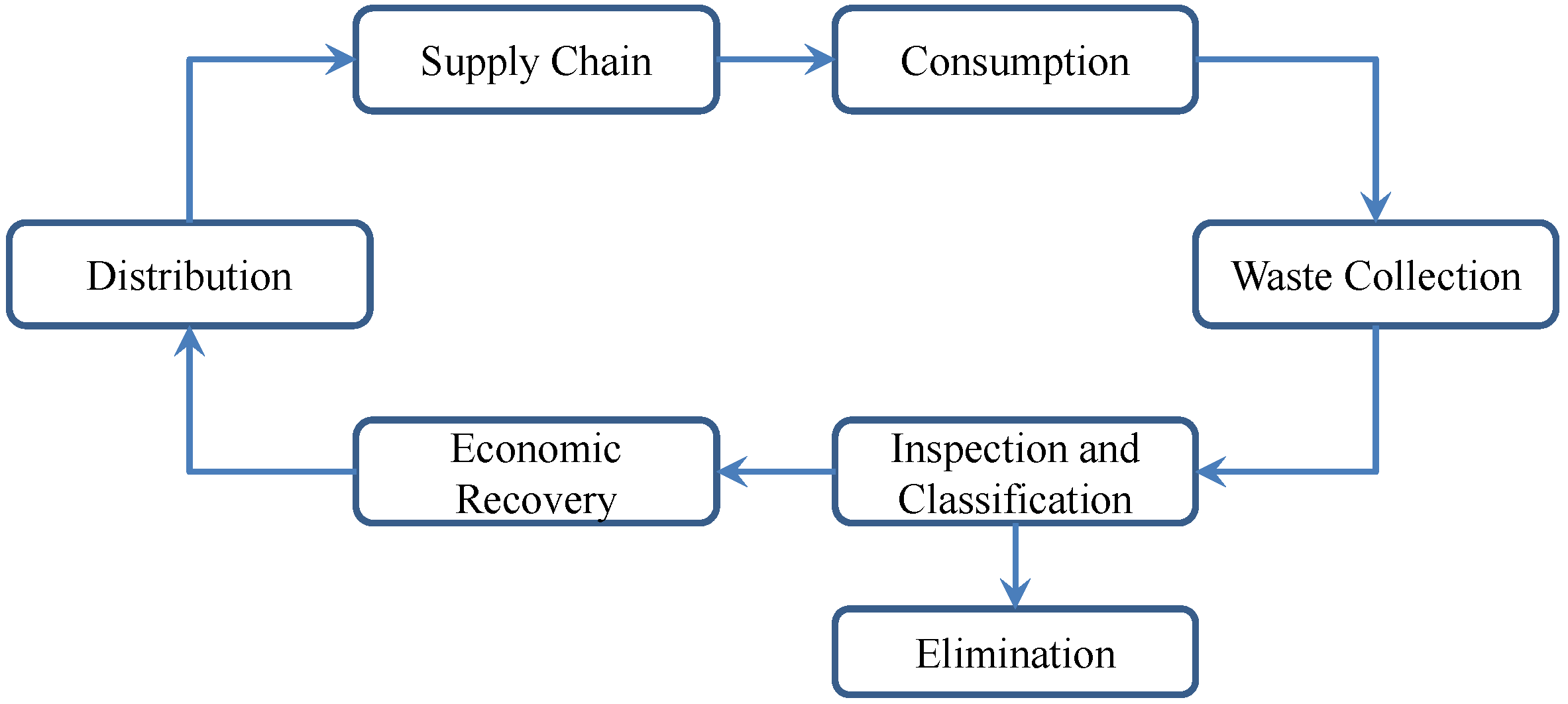
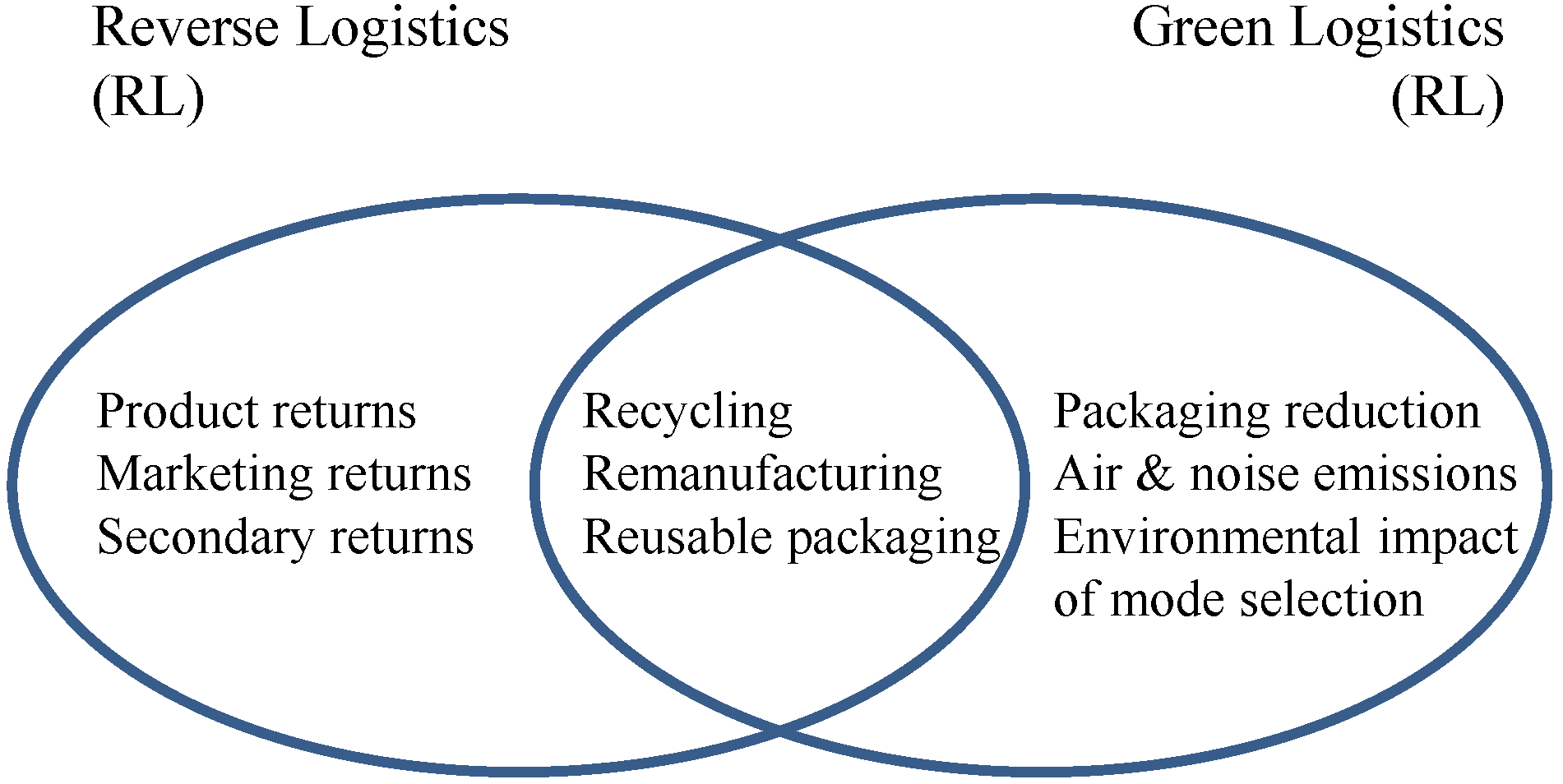

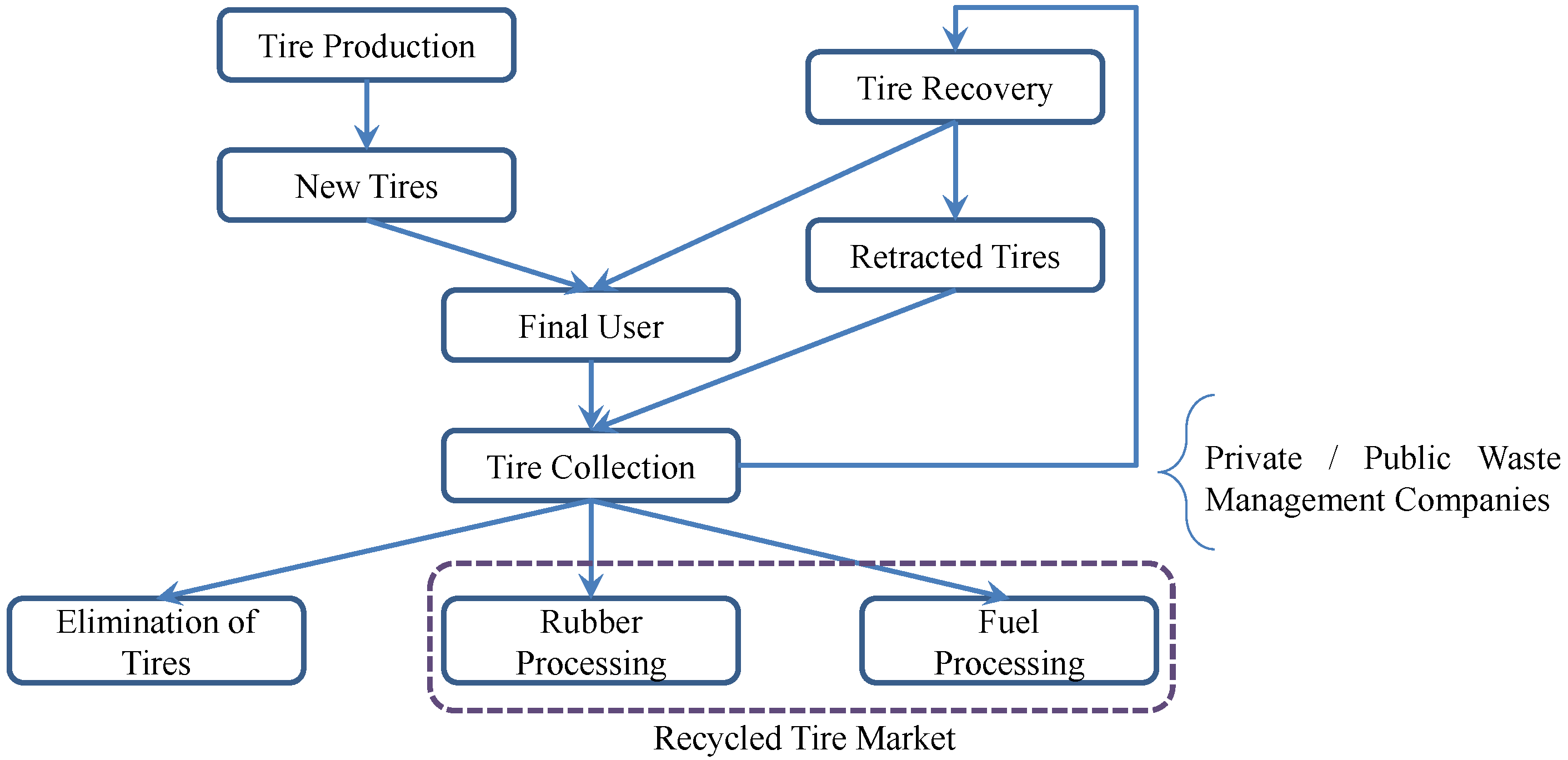
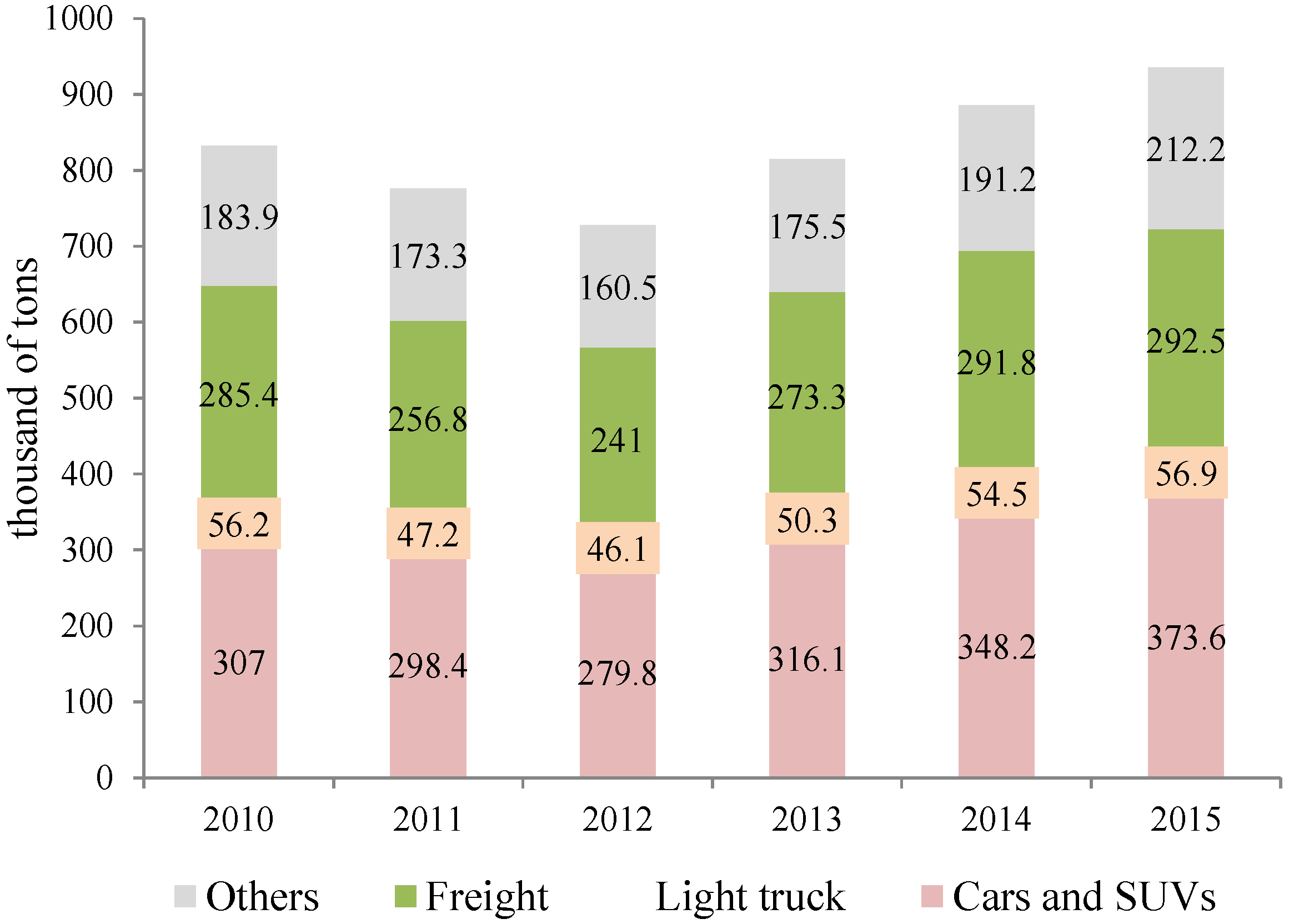

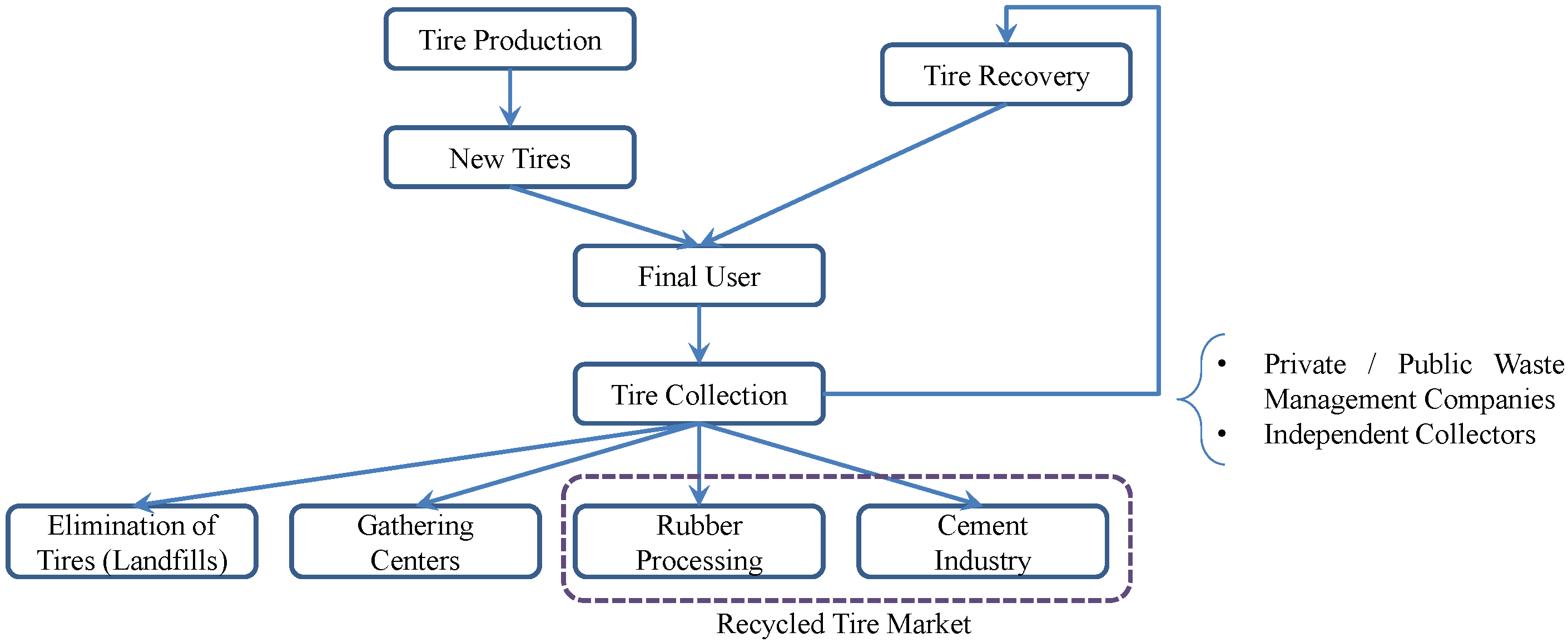
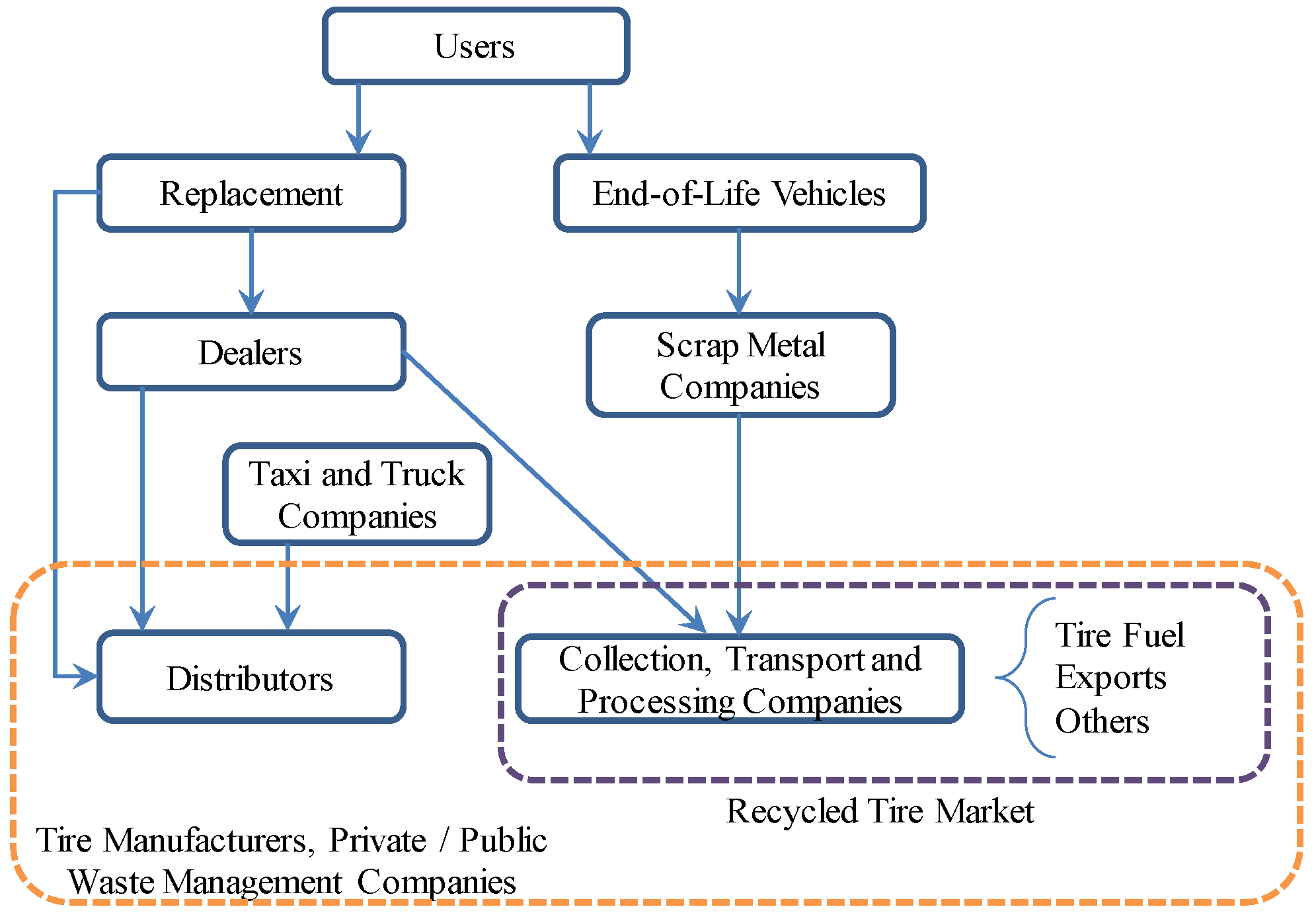
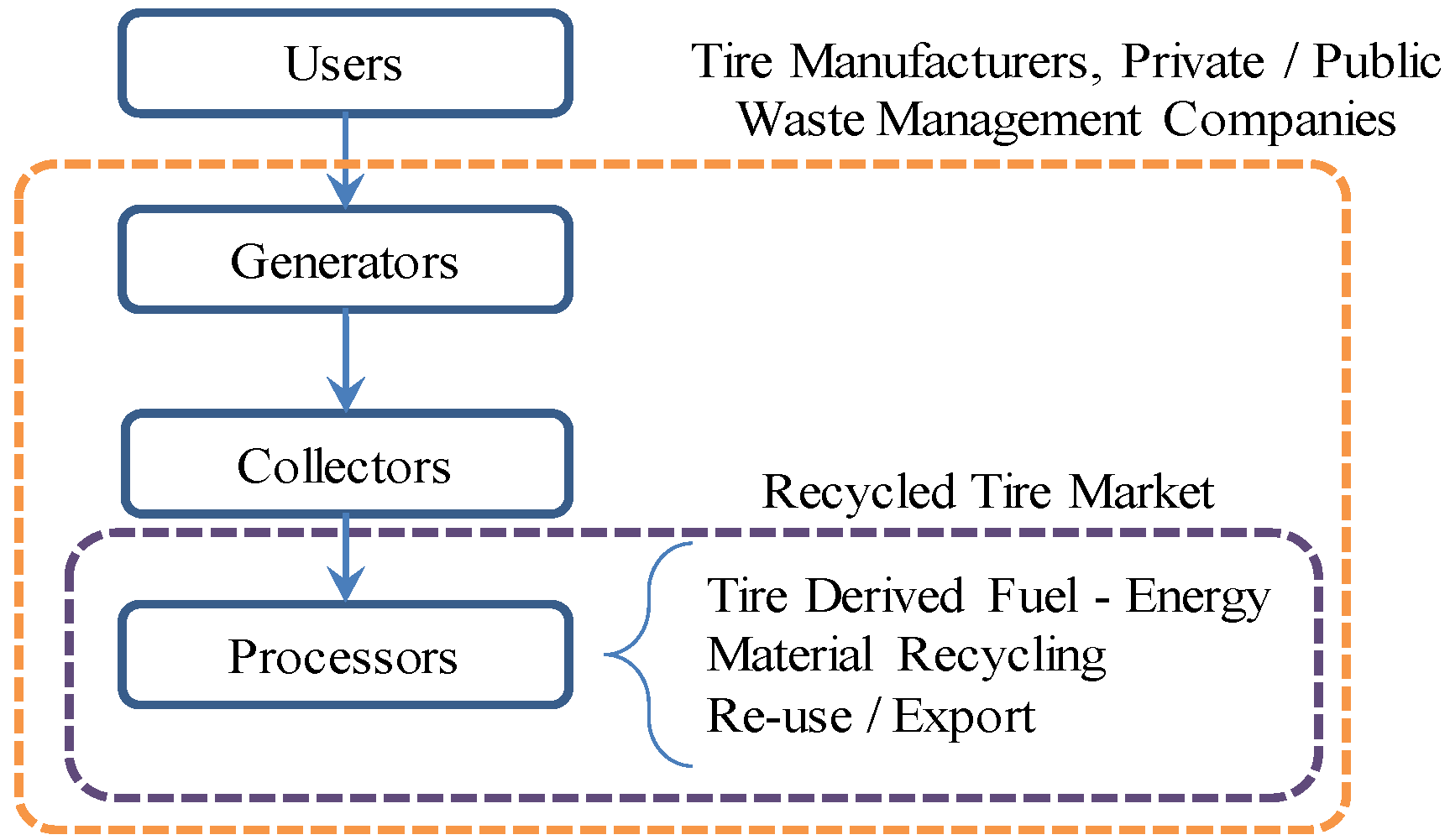
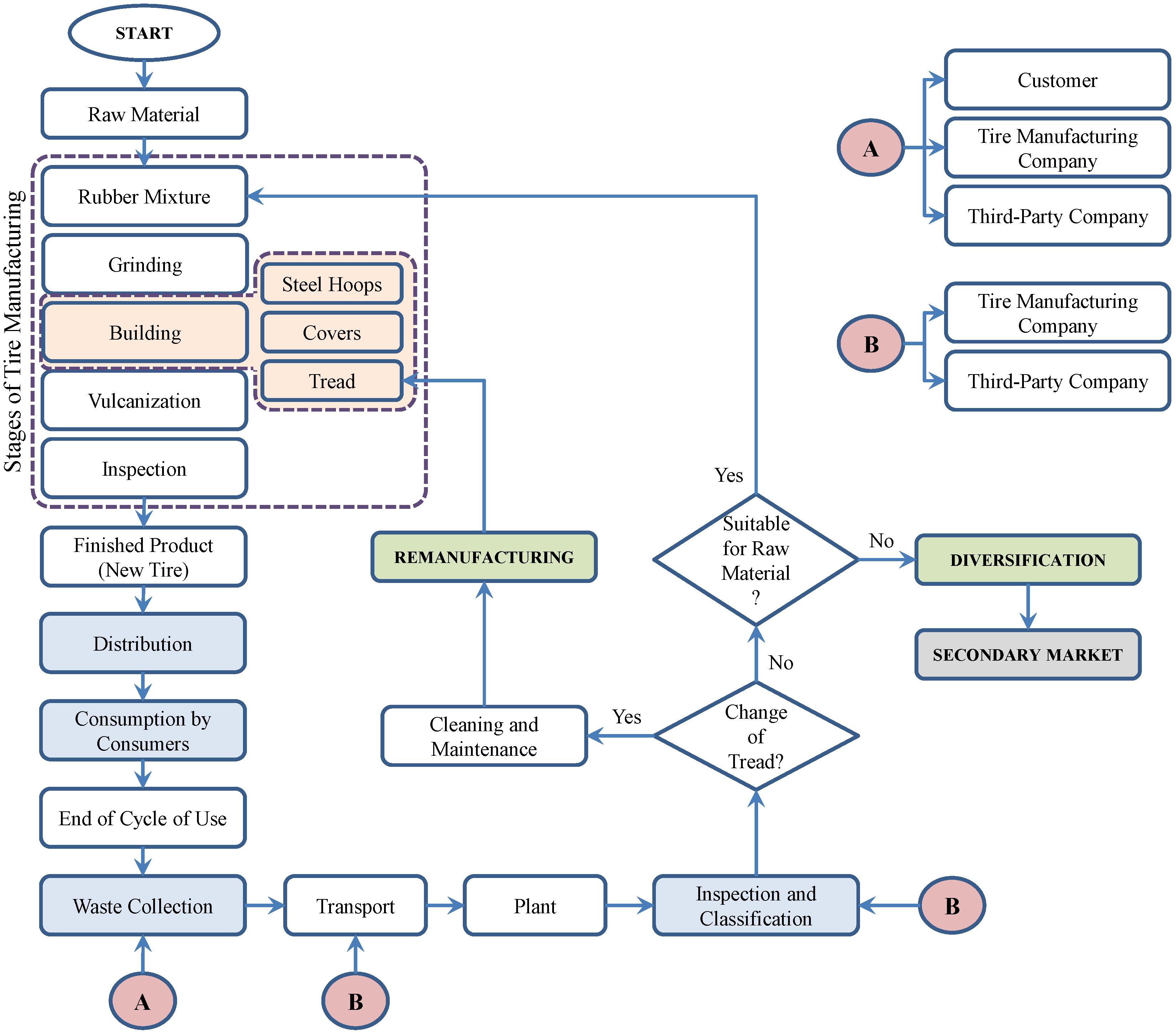
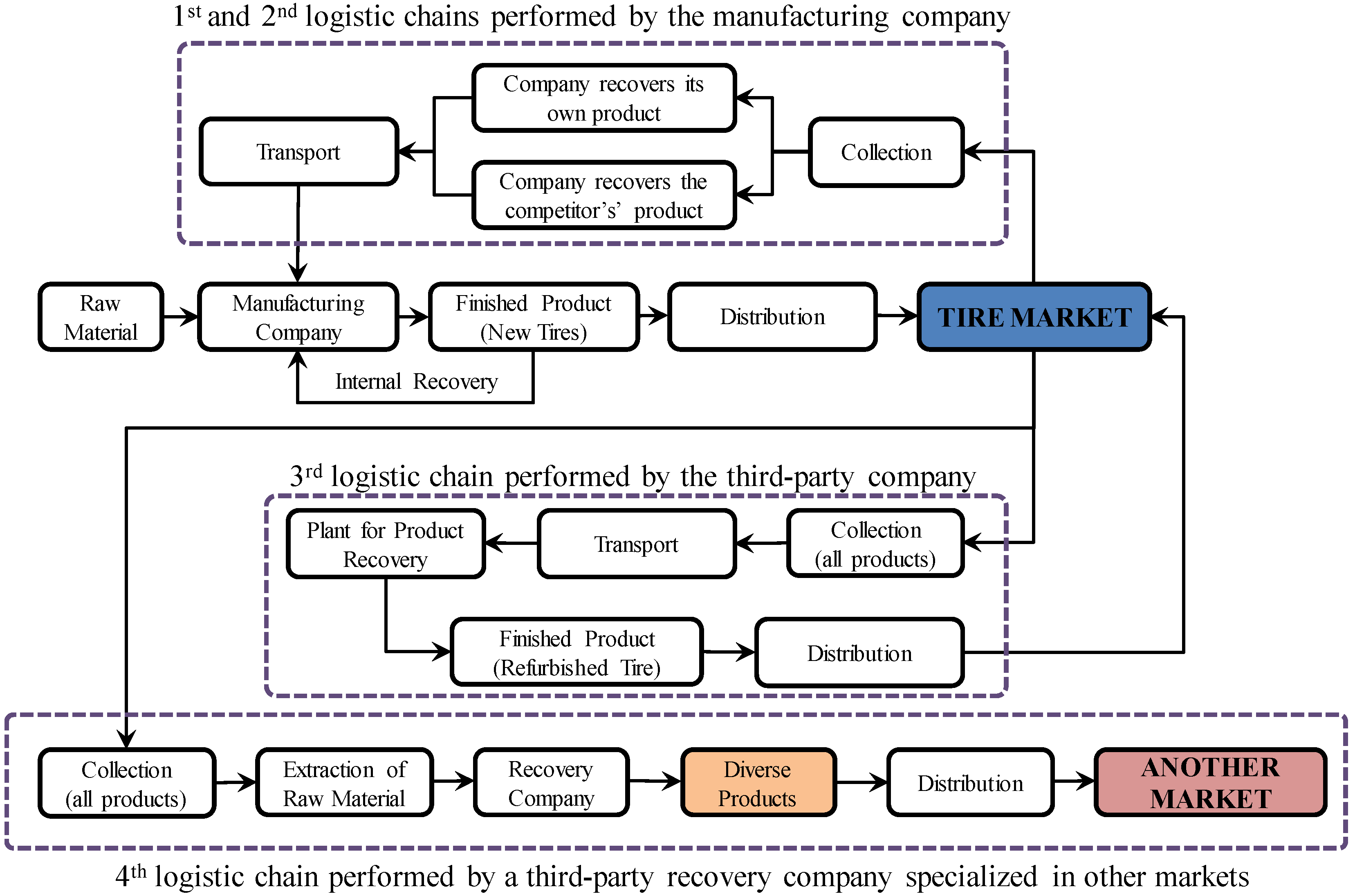
| Work | Year | Journal | Type of Contribution | Focus |
|---|---|---|---|---|
| [19] | 2018 | Procedia CIRP (College International pour la Recherche en Productique) | Strategy | Determination of differences between tire waste recycling practices in South Africa and the European Union to improve on Reverse Logistics (RL) management. |
| [20] | 2018 | Resources, Conservation & Recycling | Process | Processing strategy of tire waste into activated carbon. |
| [21] | 2018 | Journal of Cleaner Production | Strategy | Study on the implementation of the extended producer responsibility scheme for tire waste in Colombia to improve on RL management. |
| [22,23] | 2017–2018 | Resources, Conservation & Recycling—Waste Management | Process | Study on the processing of recycled tire waste to be used as polymer modifier to improve strength of epoxy based composites. |
| [24] | 2017 | Coke and Chemistry | Process | Study on the use of tire waste in coke production. |
| [25] | 2017 | Journal of Cleaner Production | Process | Study on the application of recycled tire crumbs as insulator in lightweight cellular concrete. |
| [26] | 2017 | Journal of Cleaner Production | Process | Study on the processing of polymer-rubber composites from tire waste to obtain environmentally friendly materials. |
| [27] | 2017 | Environmental Research | Process | Processing strategy of tire waste into biofilm for wastewater treatment systems. |
| [28] | 2017 | Renewable and Sustainable Energy Reviews | Process | Processing strategy of tire waste into electric energy. |
| [29] | 2017 | Journal of Material Cycles and Waste Management | Strategy | Study on the management of tire waste recycling in Taiwan. |
| [30] | 2015 | Waste Management | Strategy | Study on the management of tire waste recycling in Italy and Romania. |
| [31] | 2006 | International Journal of Environmental Technology and Management | Strategy | Study on the management of RL processes for tire waste recycling in the United States of America. |
| Activities | Strategic Decisions | Tactical Decisions | Operational Decisions |
|---|---|---|---|
| Waste Collection | (a) location, quantity and capacity of collection facilities; (b) design of technologies for collection | (a) transportation of waste for collection lefts; (b) management of collected waste inventories; (c) means of transportation | (a) collection routes; (b) collection lots; (c) load configuration |
| Inspection and Classification | (a) location, quantity and capacity of facilities for classification and inspection; (b) training of personnel | (a) inventory management of recoverable products; (b) task assignments; (c) sequencing of tasks: disassembly, cleaning, repairing | Option 3-R to be applied: reuse, re-manufacturing, recycling. |
| Economic Recovery | (a) technology; (b) effects on the long-term Production Plan | (a) effects on the aggregate Production Plan; (b) recovery lots; (c) management of inventories of recovered products | (a) effects on the Master Production Program; (b) Bill-of-Materials |
| Distribution | (a) distribution channels; (b) target markets | (a) assignment of products to markets; (b) means of transportation | (a) distribution routes; (b) distribution lots |
| Elimination | (a) removal systems; (b) target products to be eliminated | (a) management of inventories of non-recoverable products; (b) means of transportation | handling of waste |
| Scheme | Company | Third-Party: Integrated Management System | Third-Party: Logistics Professionals |
|---|---|---|---|
| Business | (a) Market leader; (b) Environmental strategy; (c) Dominant SC position | (a) Small and medium-sized enterprises; (b) Collaboration with other members of the SC | (a) Subcontracted direct logistics flow; (b) Development of the scheme for operational reasons: returns, toxic or hazardous waste |
| Product | (a) Very differentiated; (b) High added value; (c) Advanced technology; (d) Complex structure | (a) Little differentiated; (b) Low added value and residual; (c) Low technology; (d) Design for Recycling (DFR) | (a) Diversity of products; (b) Obsolete, defective, damaged, toxic or dangerous |
| Process | (a) Multiple tasks; (b) Intensive labor; (c) Very relevant transport | (a) Complex process; (b) Advanced technology; (c) High initial investment | (a) Simple process; (b) Few tasks; (c) Intensive labor |
| Market for Recovered Products | Same market as the originals | Different market than originals | (a) Share market in reuse; (b) Distinct market in returns |
| Network Design | (a) Integration of direct and reverse flows; (b) Decentralized and complex; (c) Closed-Loop; (d) Subcontracted activities | (a) Open Loop; (b) Centralized; (c) Simple with few levels; (d) Significant transport | (a) Open-loop on returns and closed-loop on reuse; (b) Simple and decentralized; (c) Significant transport |
| Reverse Scheme Goal | Recover elements of high added value | Regulatory compliance on waste | Regulatory compliance on waste and guarantees of consumption. |
| Management Options | Manufacturing | Recycling | Reuse and Returns |
| Examples | Xerox, IBM, Hewlett-Packard | Eco-glass, Eco-batteries, Eco-tires | Genco, UPS, GATX Logistics |
| Normativity | Characteristics |
|---|---|
| Basel Convention | Regulates the movement of hazardous wastes and recyclables and promotes their environmental management. |
| Federal Law 89-FZ | Regulates the production and consumption of waste and waste disposal and imposes obligations to recycle or pay an environmental duty. |
| Federal Law 458-FZ | States that manufacturers and importers of goods must provide the recycling, salvage, reclamation, and disposal of waste generated from the use of such goods including packaging which are no longer of value to consumers. |
| Federal Law on Production and Consumption of Waste | States that each region has to establish the means for waste processing such as sorting, recycling, sending to a landfill, or incinerating. |
| Decree 1886-r | States a list of finished goods, including packaging, that must be recycled at the end of their usable life. |
| GOST-8407-89 | This standard applies to worn out tires and chambers that are unsuitable for further use and recovery, as well as tires and chambers rejected by inspection results (hereinafter referred to as secondary rubber raw materials). |
| Normativity | Characteristics |
|---|---|
| Secretariat of the Environment and Natural Resources (SEMARNAT) | Attention to natural resources, biodiversity, hazardous waste, and industrial urban environmental problems. |
| General Law on Ecological Equilibrium and Environmental Protection (LGEEPA, 1988) | Environmental Impact Assessment, Hazardous Waste, Prevention and Control of Atmospheric Pollution. |
| Political Constitution of the Mexican United States (24 February 2017) | Article 115 III (Responsibility to collect waste), Transients 17 (Protection and care of the environment) and 19 (Regulation and supervision of integral waste control) |
| General Law for the Prevention and Integral Management of Waste | Protection of the environment in the field of prevention and integrated management of waste in the national territory with the aim of guaranteeing a healthy environment and promoting sustainable development. This through the prevention and integral management of hazardous waste, urban solid residues and special handling. |
| NOM-161-SEMARNAT-2011 | Establishes the criteria for classifying waste and determining which are subject to management plans, the procedure for their inclusion or exclusion, and the elements and procedures for the formulation of management plans. |
| NOM-027-SCT2/2009 | Land transport of hazardous materials and waste, special and additional specifications for containers, packaging, intermediate bulk containers, portable tanks and transport of hazardous substances and waste materials. |
| NOM-052-SEMARNAT-2005 | Establishes the characteristics, procedure for identification, classification and lists of hazardous waste (Diario Oficial de la Federación (Official Journal of the Federation), 23 June 2006). |
| ISO-14001 | Environmental Management |
| ISO-26000 | Social Responsibility |
| Basel Convention | Regulates the movement of hazardous wastes and recyclables and promotes their environmental management. |
| Rotterdam Convention | Promotes shared responsibility in international trade for certain hazardous chemicals and promote their efficient management in order to protect human health and the environment. |
| Stockholm Convention | Protects human health and the environment from the adverse effects of Persistent Organic Pollutants. |
| Normativity | Characteristics |
|---|---|
| Basel Convention | Regulates the movement of hazardous wastes and recyclables and promotes their environmental management. |
| The Japanese End-of-Life Vehicle Recycling Law | Establishment of the characteristics to be met for the disposal of end-of-life vehicles and their components. |
| Normativity | Characteristics |
|---|---|
| Basel Convention | Regulates the movement of hazardous wastes and recyclables and promotes their environmental management. |
| UNEP/CHW.10/6/Add.1 | Technical guidelines for the environmental management of used tires and waste tires. |
| Royal Decree 1619/2005 | Defines the importance of improving manufacturing techniques for tires so that they take longer to wear out, last longer, etc. |
| Royal Decree 1619/2005 on the Management of Out-of-Service Tires | Protects human health and the environment from the adverse effects of Persistent Organic Pollutants. |
| Directive 2008/98/EC | This directive establishes measures to protect the environment and human health by preventing or reducing the adverse impacts of waste generation and management, reducing the overall impacts of resource use and the effectiveness of such use. |
| Directive 2008/98/EC on Waste | This directive constitutes the current regulatory framework for the production and management of waste in the European Union. |
| Directive 2000/53/EC | This directive regulates the take-back responsibility for car-manufacturers because. Without take-back obligations for end-of-life products, there is almost no necessity for the manufacturer to coordinate the process chain beyond the point of sale. |
| Directive 2000/53/EC on End-of-Life Vehicles | This directive states that end-of-life vehicles have to be recovered and their tires have to be removed before they are scrapped. |
| Directive 1999/31/EC on the Landfill of Waste | This directive bans the disposal and stockpiling of tires on landfills. |
| Directive 2000/76/EC on Incineration of Waste | This directive prohibits combustion of end-of-life tires in old cement kilns. |
| Extended Producer Responsibility | Liberal System (Free Market) | Government Responsibility |
|---|---|---|
| Systems with take-back obligations | The legislation sets the objectives to be met but does not designate those responsible. | Government responsibility financed through a tax. |
| The original manufacturer has a duty of care to ensure that the waste from the products it has created is disposed of responsibly, in an environmentally sound manner. | All the operators in the recovery chain contract under free market conditions and act in compliance with the legislation. | Each country is responsible for the management of tire waste. |
| This may be backed up by voluntary cooperation between companies to promote best practice. | It is financed by a tax levied on tire producers and subsequently passed on to the consumer. |
| Entity | Objectives | Activities |
|---|---|---|
| Federal Government | Development of the collection market | (a) Facilitate and make attractive the collection and gathering business; (b) Develop economic stimuli and incentives; (c) Establish a list of recyclers and collectors. |
| Establishment of collection processes | (a) Define the rules of the States and Municipalities concerning the collection by their public services; (b) Supervise compliance with the provisions. | |
| Establishment of facilities for gathering | (a) Define the rules of the State and Municipalities concerning the collection lefts; (b) Monitor compliance with the provisions. | |
| State and Municipal Government | Installation of a collection system | (a) Define the rules of the State and Municipalities concerning collection lefts; (b) Monitor compliance with provisions |
| Installation of storage centers | (a) Adapt the area and request permits; (b) Define rules and charges; (c) Allocate building resources; (d) Develop economic incentives for private initiative. | |
| Government (user) | Adequate provision of tires | Direct used tires to pickers and collection lefts. |
| Large Users | Adequate provision of tires | Direct used tires to pickers and collection lefts. |
| Manufacturers, Importers and Traders | Dissemination of the collection lefts for this purpose. | Reinforce with distributors the collection of used tires to authorized sites. |
| Entity | Objectives | Activities |
|---|---|---|
| Government | Development of the recycling market | (a) Facilitate and make attractive the business of recycling; (b) Develop economic stimuli and incentives; (c) Promote and fund research programs and grant support to educational institutions and students; (d) Regulate other recycling schemes; (e) Make associations of recyclers and promote conventions; (f) Government procurement of products under recycling specifications; (g) Give preference to new developments for the use of recycled used tires and recycle content of by-products of the used tires |
| Manufacturers, Importers | Cooperation agreements | (a) Establish agreements between Technical Committees to reach consensus with the Chambers and Associations of the branch; (b) Target the collection of used waste tires to meet the needs of recyclers and grant technical support; (c) Grant support to educational institutions and students; (d) Conduct research programs for the recycling of waste tire components |
| Recyclers | Involvement | Participate in activities promoted by government and private enterprises |
| Entity | Objectives | Activities |
|---|---|---|
| Government | Development of the reuse market | (a) Facilitate and make attractive the business of reuse; (b) Develop economic stimuli and incentives; (c) Make a list of potential companies for reuse of used waste tire; (d) Promote exhibition meetings or conventions; (e) Government procurement of products under reuse specifications; (f) Give preference to new developments for used products |
| (a) Potential companies for reuse; (b) Same manufacturing company | Involvement | Participate in activities promoted by the government and private enterprises |
| Advantages | Disadvantages |
|---|---|
| (a) Extends the useful life of the tire; (b) It uses many of the original materials and much of the original structure; (c) The net result is a decrease in materials compared to the manufacture of new tires; (d) Rubber extracted from used tires prior to retreading is often sold as crushed rubber for other purposes; (e) The energy used is lower compared to the original manufacture: the energy used to retread a tire is 400 MJ while the manufacture of a new tire requires 970 MJ | (a) Concern for the volatile organic components emanating from solvents, adhesive agents and rubber compounds during vulcanization; (b) Smell can also be a problem in some places; (c) The process generates a large amount of waste |
| Products | Use | Potential Clients |
|---|---|---|
| Tire Dust | (a) Parks for children, sports tracks, asphalt; (b) Artificial grass; (c) New tires, rubber and energy source; (d) Home insulation, waterproofing; (e) Security plates; (f) Shoe soles, carpets & rugs; (g) Conveyor belts | (a) Construction equipment; (b) Suppliers of building materials; (c) Plastic Products; (d) Insulation; (e) Government; (f) Cemeteries; (g) Steel companies |
| Steel | Blast furnaces, asphalt fillers | (a) Construction equipment; (b) Suppliers of building materials; (c) Steel companies |
| Textile fibers | (a) Artificial grass; (b) Shoe soles, carpets & rugs; (c) Clothing | (a) Suppliers of building materials; (b) Plastic Products; (c) Insulation |
| Advantages | Disadvantages |
|---|---|
| It increases the demand based on supply. However if the company focuses on offering a single product, a change in the market may affect its performance. For this reason it is important that the company offers the consumer several purchase alternatives. | (a) Lack of knowledge of the market: by offering new products and services, there is the possibility of not having enough knowledge and experience of the market to which it is intended, affecting the financial resources of the company; (b) Cost: it must have a reliable economic stability so that the production of new products will not affect the company. |
© 2018 by the authors. Licensee MDPI, Basel, Switzerland. This article is an open access article distributed under the terms and conditions of the Creative Commons Attribution (CC BY) license (http://creativecommons.org/licenses/by/4.0/).
Share and Cite
Uriarte-Miranda, M.-L.; Caballero-Morales, S.-O.; Martinez-Flores, J.-L.; Cano-Olivos, P.; Akulova, A.-A. Reverse Logistic Strategy for the Management of Tire Waste in Mexico and Russia: Review and Conceptual Model. Sustainability 2018, 10, 3398. https://doi.org/10.3390/su10103398
Uriarte-Miranda M-L, Caballero-Morales S-O, Martinez-Flores J-L, Cano-Olivos P, Akulova A-A. Reverse Logistic Strategy for the Management of Tire Waste in Mexico and Russia: Review and Conceptual Model. Sustainability. 2018; 10(10):3398. https://doi.org/10.3390/su10103398
Chicago/Turabian StyleUriarte-Miranda, Maria-Lizbeth, Santiago-Omar Caballero-Morales, Jose-Luis Martinez-Flores, Patricia Cano-Olivos, and Anastasia-Alexandrovna Akulova. 2018. "Reverse Logistic Strategy for the Management of Tire Waste in Mexico and Russia: Review and Conceptual Model" Sustainability 10, no. 10: 3398. https://doi.org/10.3390/su10103398
APA StyleUriarte-Miranda, M.-L., Caballero-Morales, S.-O., Martinez-Flores, J.-L., Cano-Olivos, P., & Akulova, A.-A. (2018). Reverse Logistic Strategy for the Management of Tire Waste in Mexico and Russia: Review and Conceptual Model. Sustainability, 10(10), 3398. https://doi.org/10.3390/su10103398




